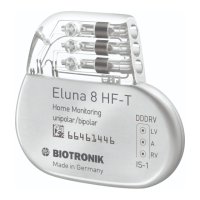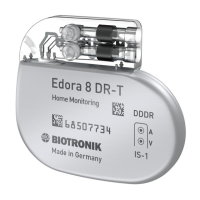Do you have a question about the BIOTRONIK Enitra 6 Series and is the answer not in the manual?
Details data recording, impedance measurements, and IEGM display.
Explains sensing, pacing thresholds, timing, and rate adaptation features.
Describes functions for synchronizing ventricular contraction using VV delays and Capture Control.
Safety information regarding cardiac electrotherapy operating conditions and risks.
Lists technical manuals, shipping, storage, temperature, and sterile delivery care.
Discusses general complications like fluid accumulation, infections, and tissue reactions.
Lists potential causes of technical failure, including lead issues and component failures.
Addresses device sensitivity to interference and BIOTRONIK's design for minimal susceptibility.
Lists procedures that may harm the patient or damage the device, like ultrasound and nerve stimulation.
Discusses risks from external electrical currents and diathermic procedures like electrocautery.
Explains device protection against defibrillation energy and potential lead damage.
Advises avoiding radiation therapy due to device damage risk and outlines safety measures if used.
Details risks of MRI due to magnetic fields and warming, and ProMRI devices.
Lists required parts and provides a general step-by-step overview of device implantation.
Covers having parts ready, keeping a defibrillator, and safely unpacking the device.
Describes general implantation locations and provides a step-by-step implantation guide.
Advises on preventing header damage, short circuits, and ensuring proper lead spacing.
Details connecting leads, using the programming head, and establishing wandless telemetry.
Explains the automatic device initialization process after lead connection.
Advises system checks, pacing threshold tests, and continuous patient monitoring.
Provides guidance on not interrupting telemetry and safe cancellation procedures.
Recommends avoiding risky parameter combinations and checking compatibility.
Advises on setting lead polarity for bipolar leads and using automatic sensitivity control.
Details functions to prevent complications like PMT protection.
Highlights risks associated with LV pacing, such as lead dislodgement and loss of therapy.
Specifies the recommended schedule for in-office follow-up appointments.
Outlines the procedure for in-house follow-up using the programmer.
Covers AV delay parameters and AV hysteresis modes, including positive/negative settings.
Details parameters for ventricular pacing, triggering, and protection.
Explains parameters for mode switching, intervention rate, and switch-to-mode criteria.
Details refractory periods for atrium, ventricle, and PVARP.
Details parameters for pulse amplitude and pulse width for different leads.
Details electrical characteristics determined at 37°C, 500 Ω.
| Brand | BIOTRONIK |
|---|---|
| Model | Enitra 6 Series |
| Category | Medical Equipment |
| Language | English |












